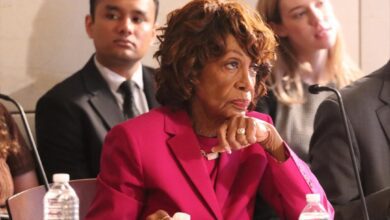
By Selen Ozturk, Ethnic Media Services
As a worsening opioid epidemic ranks among California’s most challenging crises, the Sierra Health Center is reducing harm through care over criminalization.
As a worsening opioid epidemic ranks among California’s most challenging crises, the Sierra Health Center is reducing harm through care over criminalization.
At a Thursday, January 18 briefing co-hosted by EMS and Sierra Health on the occasion of its 10th anniversary, three leaders of Sierra nonprofit grantees shared how they were innovating substance abuse prevention and advancing health equity throughout Northern California — from remote rural Inyo County, through the Central Valley, to Alameda County.
Sierra Health and substance abuse prevention
In 2022, over 109,000 Californians lost their lives due to drug overdose, according to the CDC. Overdose is the leading cause of death for non-elderly Californians — “and these numbers are expected to increase,” said Kaying Hang, president of The Center at Sierra Health Foundation.
This epidemic is the result of 50 years of federal and state governments “responding to drug use with incarceration and extreme policing under the banner of a ‘war on drugs.’ Those from communities of color have been disproportionately harmed and stigmatized,” she continued. “However, the tide is turning. People who use drugs are not strangers but our neighbors, family members, friends… and we can give them a second chance by prioritizing care over criminalization.”
Kaying Hang, president of the Center at Sierra Health Foundation, discusses the foundation’s addiction treatment strategy and why they approach treatment with healthcare rather than punishment.
This care takes the form of partnership with community-based organizations to end California’s opioid epidemic through culturally specific services which address each communities needs — including drug education, testing, harm reduction for drug users, recovery support and basic needs like food and hygiene.
“We believe that those who are closest to the harm are in the best position to determine what the solution is,” added Hang, “and our intention is to help people align with the best vision that they have of themselves.”
The myth of communities without futures
Small, heavily Latino and Filipino rural communities throughout the Central Valley like Poplar — “with over 5,000 people living in 700 dwellings that haven’t been developed for 50 years — are the most vulnerable, but least reached due to their size,” said Mari Perez-Ruiz, executive director of Central Valley Empowerment Alliance (CVEA). “For us, health access depends on fighting the narrative that our communities don’t have a future.”
Through CVEA’s Rural Health Equity Campaign, this future is youth-led.
“Pervasive drug abuse, especially fentanyl, is dire here,” said Perez-Ruiz. “Our communities are targeted by the cartels, and sometimes the parents here are using or selling drugs — so we opened LUPE (Leadership, Unity, Power, Empowerment Center) — a safe, gang-free, drug-free center for youth to come together, and have conversations with parents about trauma and harm reduction so they all see new possibilities for their lives.”
“In Poplar alone, only 3% of youth are expected to pursue higher education, yet all children in the district receive a free lunch due to living in poverty,” she added. “When so little is expected of them, we build community support by meeting people where they’re at … I see promise where others see no future.”
Mari Perez-Ruiz, Executive Director of the Central Valley Empowerment Alliance, explains how her organization is working to transcend municipal disinvestment and create community.
Native Americans and indigenous harm reduction
“Native Americans have some of the highest fatal overdose rates — not just in California, but nationwide,” said Arlene Brown, CEO of Crossroads Recovery Center and Skoden Native Harm Reduction Services in Inyo and Mono Counties, and a member of the Bishop Paiute Tribe in Inyo, where 17% of the population is Native American — though “our program is for everyone. As Natives, our core value is sharing that healing with others, and half of those we help are non-Native.”
“Since the dawn of colonization we’ve been the first victims of the war on drugs, so we seek to decolonize these services that were never built for us in the first place,” she explained.
These indigenized services include prayer tags on overdose reversal kits; in-language syringe exchange and HIV/Hepatitis C tests; distributing Narcan communitywide, including for elders who forget to take and children who accidentally take medications; and regular counseling for “spiritual, mental, physical and emotional wellness, treating the whole person and community as opposed to the Western model of care which treats isolated symptoms or parts of life.”
“”We already know shaming our loved ones for substance abuse only pushes them further away,” said Brown. “Taking away those stigmatizing barriers to care — at Crossroads, we’ve saved over 80 lives — both heals our community and protects our culture.”
“Harm reduction is a spectrum”
“When we talk about harm reduction, we need to be more ambivalent: Not everybody who is in recovery is going to get to sobriety or want to,” said Braunz Courtney, Executive Director of the HIV Education Prevention Project of Alameda County (HEPPAC).
Braunz E. Courtney, Executive Director of the HIV Education Prevention Project of Alameda County, talks about the importance of understanding a person’s readiness and goals for sobriety and providing medication-assisted treatment.
“Our goal is to meet each individual where they are geographically and, within their addiction, “where their goals are. It’s a spectrum from using drugs more safely, to abstaining completely.”
HEEPAC does this by hiring substance use navigators “with lived or living experience of recovery,” and by meeting our peers’ needs in the streets” he continued. “Recovery is not a bubble. Someone wanting to treat substance abuse is dealing with other health needs beyond the clinic like housing, food, hygiene and social interaction.”
In addition to a drop-in Oakland-based clinic, HEEPAC has mobile units and navigators providing these services alongside regular counseling, syringe exchanges, overdose education, HIV and Hep C testing, abscess wound care and Narcan carry-and-use training.
“It’s not about creating a ‘health home’ like Kaiser — you wouldn’t traditionally go there to get safe drug tools, or food, or have a frank conversation not only about what you don’t like about your drug use, but also what you do like,” Courtney said.
“For us,” he added, “It’s about creating homes wherever people are in need … We’re not here to tell you what to do. We’re navigators. Equitable health care means that those who access it tell us what they want, and we tell you how to get there. You’re the expert in your own life.”




